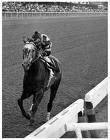Despite the European connection to the origin of grading races and the international application of U.S. grades, it must be kept in mind that our racing differs fundamentally from racing in other countries: in most countries, stakes events are set forth by a central authority, and changes to major fixtures are made under the aegis of a central governing body. U.S. racing, however, is de-centralized, and no such uniform control can exist. U.S. racing and stakes programs are dynamic products of regulatory, contractual, and competitive conditions in many local and regional environments. The U.S. grading system is designed to accommodate the flexibility and dynamism of U.S. racing; a grading system that could not quickly respond to our ever-changing conditions would never be appropriate in our country.
Judgment and flexibility thus must always be a part of the system.
-Taken from TOBA Members' Guide 2008
A claim similar to the last sentence in the first paragraph, regarding the credit markets, was made by several financial institutions.
According to the International Federation of Horseracing Authorities (IFHA), the total number of societies that organize flat racing:
- Great Britain....1
- Germany..........40
- U.S....................139
- France..............151
The American Graded Stakes Committee (AGSC) is a construct of TOBA. Six of the eleven members are TOBA members and the other five are elected by the first six. An organization of breeders is in charge of determining what races in North America deserve the best ratings that breeders can claim for their horses. WTF?
The criteria for awarding graded status are outlined in the Members' Guide and they cite an example in the INDEX but I could not find it anywhere. In essence, it's easier to figure out the nuclear launch codes, there are two general categories; each consisting of 635 parts...
- Best achievement in graded and unrestricted Black Type stakes in the 24 months before and after the race in question.
- Best annual racing performance, think Timeform, as measured by the North American Rating Committee(NARC). The NARC operates under the auspices of the Jockey Club, TOBA and the Breeders' Cup Lmtd., and the International Classification Committee.
According to the TOBA site, 103 GI races were carded this year; of these, 46 were for fillies and mares and 8 are the Breeders Cup. With apologies to the superior Distaff division, this cursory study focuses on the males. I am sure that there are myriad errors in this quick look at the grading and effect of races but I thought it might be instructive.
Forty-nine GI races remain for the males in all divisions.
I looked at GI's and set an arbitrary cutoff at 9 furlongs to see if there was a bias towards routes or sprints; I also did not include any of the Breeders' Cup races. I understand that anything less than 8f is considered a sprint for handicapping purposes but my "study" focuses on the longer/arbitrary definition of the word.
There are eleven races (22% of male races and just under 11% of all GI's) on dirt this year carded for older horses. Straight 3yo dirt races totalled nine, with nothing after the Travers, albeit the 3yos tackle the older horses by this time so we could include those races (additional 4). Turf races for older horses, surprisingly, topped the list with twelve. Only two races for 3yos, Secretariat and Hollywood Derby.
Of the forty-nine "open" GI races, thirty-four are carded at 9+ furlongs. Three year olds qualify for up to twenty (on dirt) but fourteen is probably closer to reality. There are not as many sprints carded at the GI level and, ostensibly, GI's are what breeders are pointing toward.
I don't know that KY Derby preps need to be GI races, no matter what the downstream performance of its entrants proves to be. With so many opportunities for three year olds to snag a GI, there is little reason for them to stick around another year.
I didn't feel like counting the number of races but I would guess that there are 450+ graded stakes this year.
Does that number seem a little high?





4 comments:
Too many graded stakes is a perennial criticism of the U.S. system.
This is a great article that Ray Paulick did back in 2003:
http://www.bloodhorse.com/article/19236.htm
It details the criticisms and the various changes the Committee has made over the years.
tsk tsk all things AGSC you know where you should go ;-D
I gotta do everything around here
Kerry/Handride-Well, confusticate it all. Here I thought I had caught on to something. Apparently much better treatises have been performed on this subject.
Thanks for shattering my reverie...
Didn't mean to shatter your reverie! Paulick's report is from 5 years ago, I just thought your analysis updated it nicely. I have a lot of resources on the AGSC because I wrote a major memo on it a couple summers ago.
Post a Comment